שומר לילה
…
שומר לילה בטורקיה הוא מגן פה שקוף מותאם אישית שנועד להגן על שיניים ושינויי חיוך בזמן שאנו ישנים. כאשר ברוקסיזם שינה הופך להפרעת שינה נפוצה יותר כשחרור מתח עצבי, ברוקסיזם הוא מצב הגורם לחריקת שיניים, חריקת שיניים, בדרך כלל בזמן שאנו ישנים. הכוח האגרסיבי המתמיד על השיניים שלנו יכול להוביל לנסיגה בעצב השן, שיטוח ושחיקה של משטחי שיניים, הסרת אמייל, רגישות, כאבי ראש, סתתים, אובדן שיניים, פגיעה בשיקום, כשל בשתל, הפרעה בשינה ולחץ שרירים בראש, בצוואר ובכתפיים.
FAQ
Generally if a patient has missing teeth it’s always a good idea to have implants. Having missing teeth can make certain areas difficult to chew food and so we compensate but chew on other certain areas. This creates an uneven bite force, making a select few teeth responsible for the chewing of food. This places extra stress on these teeth causing increased sensitivity and wear. Long-term, this habit can lead to more missing teeth. With implants, an evenly distributed bite force and closure can be attained. The lifetime of our natural teeth are extended and the probability of further oral conditions is reduced.
If patients are noticing receding gums, wobbly teeth, teeth falling out, the inability to eat hard foods. Then it may be a sign that patients are experiencing bone loss. When the bone recedes away from the teeth then stability is compromised and teeth begin to feel loose and fall out eventually. Diet, medications, hormone changes, and gum disease are the leading factors of bone loss. When the x-rays are assessed and an intra oral examination is performed, the doctor may suggest having teeth extracted with less than 30% connection with bone structure. These patients are then suggested implants for crowns or fixed dentures to regain a confident, healthy smile. Bone loss is very common to see in all on 4 and all on 6 patients.
The doctor uses computer software of the patients x-ray and tomography to find the best placement of implants. The patient relaxes in the dental chair and within sterile conditions. The surgeon and assistants sterilise their hands, wear gloves, masks, surgical gowns, hair nets and sterilise the patients mouths, inside and out. The treatment may begin. The maxillofacial surgeon applies local anaesthesia for a pain free operation. The gingiva (gum) is opened and bone exposed. The surgeon prepares the implant socket with the help of dental drills to the appropriate size and diameter. The implant is placed in the prepared socket with a little bit of bone graft. The gingiva is then closed with dissolvable stitches. The stitches disappear in 7 to 10 days.
Dental implants are produced of a titanium alloy which is highly biocompatible with the human body. The rate of allergy or tissue reaction is negligibly low. So dental implants are a very safe material for humans.










